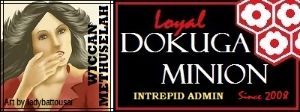Plagiarism - Is it REALLY so BAD?
What is Plagiarism?
Fanfiction Plagiarism
Plagiarism means many things to many people in the fanfiction world. After all, we write stories based on someone else’s already published work, don’t we? So who cares if we “borrow” a story from someone else who has already “borrowed” from the published author?
Dokuga cares. A LOT.
It doesn’t matter to us if a story has been unfinished for 10 years... you can’t take it and “finish” it without permission from the original author. You cannot take a story and change the names and call it your own. You can’t take the plot of another story, sequence for sequence, change a few words or scenes here or there, and call it yours.
Plagiarism of Published Works
While Dokuga has a blanket disclaimer on the bottom of each page with regard to InuYasha, the anime and the manga, if you are writing a cross-over with another fandom, you must put an attribution in your Author’s Notes. Attribution is covered in a separate tutorial.
You also cannot, for any reason, copy anything written by a published author without attributing it and/or obtaining permission from the original author to use it. We have had several instances where people take their favorite romance novel and simply change the names, copying the published work either word for word or in part. This is NOT ALLOWED. That is plagiarism.
If the Site Administrators deem that you have plagiarized another fanfiction author, or plagiarized published works,
your profile AND all your stories will be IMMEDIATELY DELETED. Plagiarism endangers the site as a whole, opening it to lawsuits, hence the harsh response.
What Is NOT Plagiarism?
We are all working within the same framework set out by Rumiko Takahashi. There are a finite number of things that we can do with the characters and, since fanfiction has been around for eons, there will be some stories that resemble others in plot devices, overall plot, original characters and settings. Please keep that in mind when you suspect that you are reading something that sounds like something you read before. Don’t cry plagiarism at the drop of a hat for what is termed “shared cliche.”
Shared cliche encompasses many things. To attempt to define it simply, I use the following examples:
Story A has Kagome running away from InuYasha, Sesshoumaru rescuing her, taking her back to his citadel, and them getting together. Story A has InuYasha being an idiot, running after Kikyou and driving Kagome away, with Sesshoumaru being kind and understanding of Kagome’s feelings.
Story B also has Kagome running away from InuYasha, Sesshoumaru rescuing her, taking her back to his citadel, and them getting together. Story B has InuYasha being abusive, attacking Kagome, and Sesshoumaru isn’t very kind and treats Kagome like a slave at first.
Both stories have similar plots. Both stories may have similar dialogue as regards certain things. But both stories are, ultimately, NOT the same.
These are simplistic examples, but I think you get the idea. Story B is NOT plagiarizing Story A simply because the basic plot is the same.
What To Do If You Suspect Plagiarism
Contact a Site Administrator. DO NOT confront the author via a review. Review abuses will be dealt with in another tutorial. DO NOT confront the author via a Private Message. Take your concerns, and your reasons for your concerns, as well as any evidence you might have of the suspected plagiarism, to a Site Administrator. Let us do our jobs!

~~Wiccan~~







